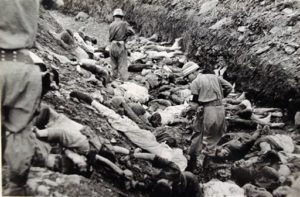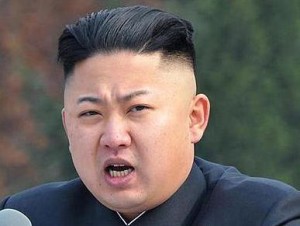Why North Korea Wants Nuke Deterrence
THIS INFORMATION HAS BEEN RECOMMENDED TO TGP BY OUR COLLEAGUE FELICITY ARBUTHNOT.
By Nicolas J S Davies, Consortium News

In what has become a shopworn rite for politicians and propagandists, US presidents visit "high-value" imperial outposts, rub elbows with the imperial troopers. For almost 70 years South Korea has been a critical piece in Washington's containment strategies aimed at China and Russia. In this image, near the ceasefire line between North and South Korea, Barack Obama uses binoculars to view the DMZ from Camp Bonifas, March 25, 2012. (Official White House Photo by Pete Souza)
The Western media has been awash in speculation as to why, about a year ago, North Korea’s “crazy” leadership suddenly launched a crash program to vastly improve its ballistic missile capabilities. That question has now been answered.
In September 2016, North Korean cyber-defense forces hacked into South Korean military computers and downloaded 235 gigabytes of documents. The BBC has revealed that the documents included detailed U.S. plans to assassinate North Korea’s president, Kim Jong Un, and launch an all-out war on North Korea. The BBC’s main source for this story is Rhee Cheol-Hee, a member of the Defense Committee of the South Korean National Assembly.
These plans for aggressive war have actually been long in the making. In 2003, the U.S. scrapped an agreement signed in 1994 under which North Korea suspended its nuclear program and the U.S. agreed to build two light water reactors in North Korea. The two countries also agreed to a step-by-step normalization of relations. Even after the U.S. scrapped the 1994 Agreed Framework in 2003, North Korea did not restart work on the two reactors frozen under that agreement, which could by now be producing enough plutonium to make several nuclear weapons every year.
However, since 2002-03, when President George W. Bush included North Korea in his “axis of evil,” withdrew from the Agreed Framework, and launched an invasion of Iraq over bogus WMD claims, North Korea once again began enriching uranium and making steady progress toward developing nuclear weapons and ballistic missiles to deliver them.
By 2016, the North Koreans also were keenly aware of the horrific fate of Iraq and Libya and their leaders after the countries did surrender their unconventional weapons. Not only did the U.S. lead bloody “regime change” invasions but the nations’ leaders were brutally murdered, Saddam Hussein by hanging and Muammar Gaddafi sodomized with a knife and then summarily shot in the head.

Gaddafi murdered, after being character-assassinated by the Western press. The standard procedure. Put it on Clinton and Obama's tab—and a zillion accomplices, but the entire Western establishment is guilty. (Oct. 20, 2011)
.
So, the discovery of the U.S. war plan in 2016 sounded alarm bells in Pyongyang and triggered an unprecedented crash program to quickly expand North Korea’s ballistic missile program. Its nuclear weapons tests established that it can produce a small number of first-generation nuclear weapons, but it needed a viable delivery system before it could be sure that its nuclear deterrent would be credible enough to deter a U.S. attack.
In other words, North Korea’s main goal has been to close the gap between its existing delivery systems and the missile technology it would need to actually launch a retaliatory nuclear strike against the United States [or other high-value targets such as Guam, Japan or South Korea]. North Korea’s leaders see this as their only chance to escape the same kind of mass destruction visited on North Korea in the first Korean War, when U.S.-led air forces destroyed every city, town and industrial area and General Curtis LeMay boasted that the attacks had killed more than 20 percent of the population.

In this July 1950 U.S. Army file photograph once classified “top secret,” South Korean soldiers walk among some of the thousands of South Korean political prisoners shot at Taejon, South Korea, early in the Korean War.(AP Photo/National Archives, Major Abbott/U.S. Army, File)
Through 2015 and early 2016, North Korea only tested one new missile, the Pukkuksong-1 submarine-launched missile. The missile launched from a submerged submarine and flew 300 miles on its final, successful test, which coincided with the annual U.S.-South Korean military exercises in August 2016.
North Korea also launched its largest satellite to date in February 2016, but the launch vehicle seemed to be the same type as the Unha-3 used to launch a smaller satellite in 2012.
However, since the discovery of the U.S.-South Korean war plans a year ago, North Korea has vastly accelerated its missile development program, conducting at least 27 more tests of a wide range of new missiles and bringing it much closer to a credible nuclear deterrent. Here is a timeline of the tests:
–Two failed tests of Hwasong-10 medium-range ballistic missiles in October 2016.
–Two successful tests of Pukguksong-2 medium-range ballistic missiles, in February and May 2017. The missiles followed identical trajectories, rising to a height of 340 miles and landing in the sea 300 miles away. South Korean analysts believe this missile’s full range is at least 2,000 miles, and North Korea said the tests confirmed it is ready for mass production.
–Four medium-range ballistic missiles that flew an average of 620 miles from the Tongchang-ri space center in March 2017.
–Two apparently failed missile tests from Sinpo submarine base in April 2017.
–Six tests of Hwasong-12 medium-range ballistic missiles (range: 2,300 to 3,700 miles) since April 2017.
–A failed test of a missile believed to be a “KN-17” from Pukchang airbase in April 2017.
–Test of a Scud-type anti-ship missile that flew 300 miles and landed in the Sea of Japan, and two other tests in May 2017.
–Several cruise missiles fired from the East coast in June 2017.
–A test of a powerful new rocket engine, maybe for an ICBM, in June 2017.
–North Korea tested two Hwasong-14 “near-ICBMs” in July 2017. Based on these tests, the Hwasong-14 may be capable of hitting city-sized targets in Alaska or Hawaii with a single nuclear warhead, but cannot yet reach the U.S. West Coast.
–Four more missiles tested in August 2017, including a Hwasong-12 that flew over Japan and travelled 1,700 miles before breaking up, maybe as a result of a failure in a “Post Boost Vehicle” added to improve range and accuracy.
–Another ballistic missile flew 2,300 miles over the Pacific on September 15, 2017.
An analysis of the two tests of the Hwasong-14 in July by the Bulletin of the Atomic Scientists (BAS) concluded that these missiles are not yet capable of carrying a 500 kg payload as far as Seattle or other U.S. West Coast cities. BAS notes that a first generation nuclear weapon based on the Pakistani model that North Korea is believed to be following could not weigh less than 500 kg, once the weight of the warhead casing and a heat shield to survive reentry into the Earth’s atmosphere are taken into account.
Global Reaction
[dropcap]A[/dropcap]wareness of the role of the U.S. war plan in spurring the dramatic escalation of North Korea’s missile program should be a game changer in the world’s response to the crisis over Korea, since it demonstrates that the current acceleration of the North Korean missile program is a defensive response to a serious and potentially existential threat from the United States.
If the United Nations Security Council was not diplomatically and militarily intimidated by the United States, this knowledge should trigger urgent action in the Security Council to require all sides to make a firm commitment to peaceful and binding diplomacy to formally end the Korean War and remove the threat of war from all the people of Korea. And the whole world would unite politically and diplomatically to prevent the U.S. from using its veto to avoid accountability for its leading role in this crisis. Only a unified global response to potential U.S. aggression could possibly convince North Korea that it would have some protection if it eventually halted its nuclear weapons program.
But such unity in the face of a threat of U.S. aggression would be unprecedented. Most U.N. delegates quietly sat and listened on Sept. 19 when President Donald Trump delivered explicit threats of war and aggression against North Korea, Iran and Venezuela, while boasting about his missile strike against Syria on April 6 over dubious and disputed claims about a chemical weapons incident.

Trump issuing reckless threats and bloviating at the UNGA. Most members should have at least walked out if not booed, but cowardice prevailed and most remained silent and seated.
For the past 20 years or more, the United States has swaggered about as the “last remaining superpower” and the “indispensable nation,” a global law unto itself, using the dangers of terrorism and weapons proliferation and highly selective outrage over “dictators” as propaganda narratives to justify illegal wars, CIA-backed terrorism, its own weapons proliferation, and support for its favored dictators like the brutal rulers of Saudi Arabia and other Arab monarchies.
For even longer, the United States has been two-faced about international law, citing it when some adversary can be accused of a violation but ignoring it when the U.S. or its allies are trampling on the rights of some disfavored country. When the International Court of Justice convicted the United States of aggression (including acts of terrorism) against Nicaragua in 1986, the U.S. withdrew from the ICJ’s binding jurisdiction.
Since then, the U.S. has thumbed its nose at the entire structure of international law, confident in the political power of its propaganda or “information warfare” to cast itself as the guardian of law and order in the world, even as it systematically violates the most basic rules spelled out in the U.N. Charter and the Geneva Conventions.
U.S. propaganda treats the U.N. Charter and the Geneva Conventions, the world’s “Never again” to war, torture and the killing of millions of civilians in the Second World War, as relics of another time that it would be naive to take seriously.
But the results of the U.S. alternative — its lawless “might makes right” war policy — are now plain for all to see. In the past 16 years, America’s post-9/11 wars have already killed at least two million people, maybe many more, with no end in sight to the slaughter as the U.S.’s policy of illegal war keeps plunging country after country into intractable violence and chaos.
An Ally’s Fears
[dropcap]J[/dropcap]ust as North Korea’s missile programs are a rational defense strategy in the face of the threat Pyongyang faces from the U.S., the exposure of the U.S.’s war plan by American allies in South Korea is also a rational act of self-preservation, since they too are threatened by the possibility of war on the Korean peninsula.

The shameless warmongering demagog Obama visiting Korea. The liberals' moral and intellectual bankruptcy is mirrored in their adoration of this man.
Now maybe other U.S. allies, the wealthy countries that have provided political and diplomatic cover for the U.S.’s 70-year campaign of illegal war, will finally reassert their humanity, their sovereignty and their own obligations under international law, and start to rethink their roles as junior partners in U.S. aggression.
Countries like the U.K., France and Australia will sooner or later have to choose between forward-looking roles in a sustainable, peaceful multi-polar world and a slavish loyalty to the ever-more desperate death throes of U.S. hegemony. Now might be a good moment to make that choice, before they are dragged into new U.S. wars in Korea, Iran or Venezuela.
Even Sen. Bob Corker, R-Tennessee, chairman of the Senate Foreign Relations Committee, is afraid that Donald Trump will lead humanity into World War III. But it might come as a surprise to people in Iraq, Afghanistan, Syria, Yemen, Somalia, Libya and parts of a dozen other countries already engulfed by U.S.-driven wars to learn that they are not already in the midst of World War III. [Editor's Note: Ironically, much of Trump's ostensibly demented warmongering was prompted by constant harassment by the Democrats, their media shills and the CIA for supposedly being "too conciliatory toward Russia," "a puppet of Putin," and similar idiocies. This still ongoing campaign of lies—"Russiagate"— definitely had the undesirable effect of pushing Trump to a more outlandish course of militarism, which has brought enormous profits to the arms industries but also endangered the peace of the world, itself a capital crime under Nuremberg statutes.—PG)
Perhaps what really worries the Senator is that he and his colleagues may no longer be able to sweep these endless atrocities under the plush carpets of the halls of Congress without a genteel Barack Obama in the White House to sweet-talk U.S. allies around the world and keep the millions being killed in U.S. wars off U.S. TVs and computer screens, out of sight and out of mind.
If politicians in the U.S. and around the world need the ugliness of Donald Trump as a mirror for their own greed, ignorance and temerity, to shame them into changing their ways, so be it – whatever it takes. But it should not escape anyone anywhere that the signature on this diabolical war plan that now threatens to kill millions of Koreans was not Donald Trump’s but Barack Obama’s.
George Orwell might well have been describing the partisan blindness of the West’s self-satisfied, so easily deluded, neoliberal society when he wrote this in 1945,
“Actions are held to be good or bad, not on their own merits, but according to who does them, and there is almost no kind of outrage – torture, the use of hostages, forced labor, mass deportations, imprisonment without trial, forgery, assassination, the bombing of civilians – which does not change its color when it is committed by our side… The Nationalist not only does not disapprove of atrocities committed by his own side, but he has a remarkable capacity for not even hearing about them.”
.
Here’s the bottom line: The United States has been planning to assassinate Kim Jong Un and to launch an all-out war on North Korea. There. You’ve heard it. Now, can you still be manipulated into believing that Kim Jong Un is simply “crazy” and North Korea is the gravest threat to world peace?
Or do you now understand that the United States is the real threat to peace in Korea, just as it was in Iraq, Libya and many other countries where the leaders were deemed “crazy” and U.S. officials (and the Western mainstream media) promoted war [or assassination] as the only “rational” alternative?
[premium_newsticker id=”154171″]
NICOLAS DAVIES—When the International Court of Justice convicted the United States of aggression (including acts of terrorism) against Nicaragua in 1986, the U.S. withdrew from the ICJ’s binding jurisdiction. Since then, the U.S. has thumbed its nose at the entire structure of international law, confident in the political power of its propaganda or “information warfare” to cast itself as the guardian of law and order in the world, even as it systematically violates the most basic rules spelled out in the U.N. Charter and the Geneva Conventions.

This work is licensed under a Creative Commons Attribution-NonCommercial 4.0 International License.
WANTED: MEDIA FELONS
All abject servants of the plutocracy
Parting shot—a word from the editors
The Best Definition of Donald Trump We Have Found
 In his zeal to prove to his antagonists in the War Party that he is as bloodthirsty as their champion, Hillary Clinton, and more manly than Barack Obama, Trump seems to have gone “play-crazy” -- acting like an unpredictable maniac in order to terrorize the Russians into forcing some kind of dramatic concessions from their Syrian allies, or risk Armageddon.However, the “play-crazy” gambit can only work when the leader is, in real life, a disciplined and intelligent actor, who knows precisely what actual boundaries must not be crossed. That ain’t Donald Trump -- a pitifully shallow and ill-disciplined man, emotionally handicapped by obscene privilege and cognitively crippled by white American chauvinism. By pushing Trump into a corner and demanding that he display his most bellicose self, or be ceaselessly mocked as a “puppet” and minion of Russia, a lesser power, the War Party and its media and clandestine services have created a perfect storm of mayhem that may consume us all.— Glen Ford, Editor in Chief, Black Agenda Report
In his zeal to prove to his antagonists in the War Party that he is as bloodthirsty as their champion, Hillary Clinton, and more manly than Barack Obama, Trump seems to have gone “play-crazy” -- acting like an unpredictable maniac in order to terrorize the Russians into forcing some kind of dramatic concessions from their Syrian allies, or risk Armageddon.However, the “play-crazy” gambit can only work when the leader is, in real life, a disciplined and intelligent actor, who knows precisely what actual boundaries must not be crossed. That ain’t Donald Trump -- a pitifully shallow and ill-disciplined man, emotionally handicapped by obscene privilege and cognitively crippled by white American chauvinism. By pushing Trump into a corner and demanding that he display his most bellicose self, or be ceaselessly mocked as a “puppet” and minion of Russia, a lesser power, the War Party and its media and clandestine services have created a perfect storm of mayhem that may consume us all.— Glen Ford, Editor in Chief, Black Agenda Report
window.newShareCountsAuto="smart";





